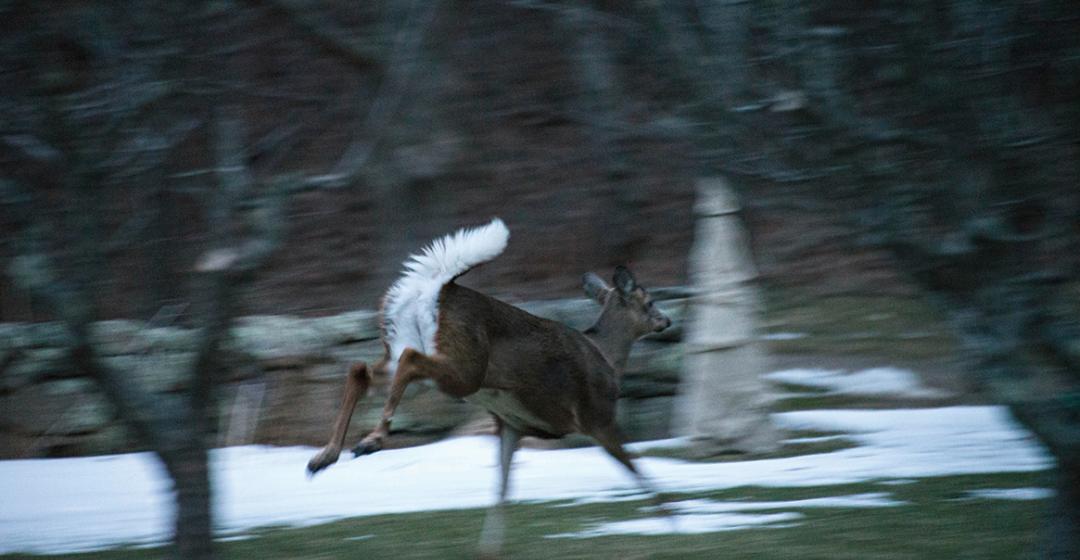My hunting resume is a little thin. I once shot at some partridge (the operative word being “at”). And then there was the time when I was about ten that, much to my astonishment, I shot a rabbit with a bow and arrow – wounding him. I panicked. I brought him home and my mother packed him up in a shoebox, got in the car, and said she would take him to the vet. And that’s about it.
Ned Casey of Edgartown is cut from a different cloth. He’s been hunting for over forty years. Shot his first deer when he was fifteen, brought it home and dressed it himself.
For Casey it all begins with shot placement. If you shoot the deer in a vital area – the heart or the lungs – it’s going to bleed out quickly and it’s going to be easier to take care of. If the deer ends up running away, in some cases for hours, the deer is stressed and lactic acid builds up, which changes both the flavor and the texture of the meat. So the best way to get high quality meat is to make a good shot.
When it comes to gutting the deer, the first rule is to do it as quickly as possible in order to get the animal’s core temperature down, which lessens the breeding of bacteria. Many hunters gut the deer in the field, which has the added benefit of reducing the weight of the animal by around 15 percent, making it easier to carry back to the vehicle.
“One mistake a lot of guys do,” Casey explains, “is they make a long incision from all the way up the breastplate down to the hindquarters. I make an incision just long enough to be able to get my hands up inside the body cavity. The reason for a small incision is that exposure to air causes bacteria to form. So you make a small incision, and clean out all the organs from the base of the neck to the sex organs. If it’s a male, I leave the sex organs, they don’t do any harm.”
The next step of the process is hanging the deer, and it’s best to do it somewhere where there’s a consistently cold temperature. If you hang it outside, depending on the time of the year, the temperature can fluctuate from fifty to sixty in the day down to the thirties at night and that can cause bacteria to build up. Casey recommends using a walk-in cooler, if possible; there are several places on the Island where you can rent space.
“If you don’t have access to a cooler, some guys will use ice chests,” Casey adds. “You just quarter (the deer) and put ice in the chests and cool it down that way.”
If you do hang the deer, wipe down the body cavity with paper towels so it’s dry. Casey says that there is also a spray that meat cutters use that can be applied and then wiped out that will reduce the growth of bacteria.
“I like to hang my deer from seven to ten days,” Casey explains. “Aging contributes to the flavor and tenderness.”
After it’s hung, it’s time to skin the deer. You start with the brisket (sternum), slice out to the forelegs and then branch out to the hindquarters and work the skin off. It should all come off in one piece. For Casey, the whole process takes about fifteen to twenty minutes.
Once skinned, it’s time to butcher the meat. The hindquarters provide the choicest cuts for various kinds of steaks. The shoulders are a bit tougher and are good for sausage or ground venison. And if you want chops, you can take a band saw and cut through the middle of the torso and you’re left with two racks of ribs.
“The less handling of meat, the better,” Casey explains. “You want to get it done as quickly and efficiently as possible, with the least exposure to air.” Sanitation is very important and Casey works on a stainless steel counter and uses stainless steel bowls, all meticulously cleaned. Then he vacuum-seals all the cuts of meat.
Casey figures that about half the hunters on the Island cut their own meat, but if you’d rather leave that to the pros, there are local butchers that will do it for you.
But for Casey, processing the deer is as much a part of hunting as the shooting.
“For me, it’s kind of a ritual,” he explains. “I usually have two or three guys come over, fire up the grill, get some cheese and salami and have a bottle of wine. The whole process takes about two and a half to three hours and it’s a fun time – it adds to the whole experience.”
And above all, he says, you have to have respect: “A lot of guys laugh and say, ‘hey we’re higher on the food chain,’ but I say you have to honor the animal and I’m grateful to it because it gave its life for me, and for that it deserves my respect.”





